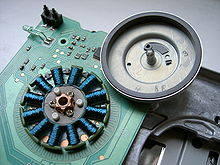This is an old revision of this page, as edited by Bri (talk | contribs) at 05:03, 17 December 2007 (fmt & rv linkspam). The present address (URL) is a permanent link to this revision, which may differ significantly from the current revision.
Revision as of 05:03, 17 December 2007 by Bri (talk | contribs) (fmt & rv linkspam)(diff) ← Previous revision | Latest revision (diff) | Newer revision → (diff)A brushless DC motor (BLDC) is a synchronous electric motor that from a modeling perspective looks exactly like a DC motor, having a linear relationship between current and torque, voltage and rpm. It is an electronically controlled commutation system, instead of a mechanical commutation system (ie. brushes).

Two subtypes exist:
- The stepper motor type may have more poles on the stator.
- The reluctance motor.
In a conventional (brushed) DC motor, the brushes make mechanical contact with a set of electrical contacts on the rotor (called the commutator), forming an electrical circuit between the DC electrical source and the armature coil-windings. As the armature rotates on axis, the stationary brushes come into contact with different sections of the rotating commutator. The commutator and brush system form a set of electrical switches, each firing in sequence, such that electrical-power always flows through the armature coil closest to the stationary stator (permanent magnet).
In a BLDC motor, the electromagnets do not move; instead, the permanent magnets rotate and the armature remains static. This gets around the problem of how to transfer current to a moving armature. In order to do this, the brush-system/commutator assembly is replaced by an intelligent electronic controller. The controller performs the same power distribution found in a brushed DC motor, but using a solid-state circuit rather than a commutator/brush system.
Comparison with brushed DC motors

BLDC motors offer several advantages over brushed DC motors, including higher efficiency and reliability, reduced noise, longer lifetime (no brush erosion), elimination of ionizing sparks from the commutator, and overall reduction of electromagnetic interference (EMI). The maximum power that can be applied to a BLDC motor is exceptionally high, limited almost exclusively by heat, which can damage the magnets. BLDC's main disadvantage is higher cost, which arises from two issues. First, BLDC motors require complex electronic speed controllers to run. Brushed DC motors can be regulated by a comparatively trivial variable resistor (potentiometer or rheostat), which is inefficient but also satisfactory for cost-sensitive applications. Second, many practical uses have not been well developed in the commercial sector. For example, in the RC hobby scene, even commercial brushless motors are often hand-wound while brushed motors use armature coils which can be inexpensively machine-wound.
BLDC motors are considered to be more efficient than brushed DC motors. This means that for the same input power, a BLDC motor will convert more electrical power into mechanical power than a brushed motor, mostly due to the absence of friction of brushes. The enhanced efficiency is greatest in the no-load and low-load region of the motor's performance curve. Under high mechanical loads, BLDC motors and high-quality brushed motors are comparable in efficiency.
Controller implementations
Because the controller must direct the rotor rotation, the controller needs some means of determining the rotor's orientation/position (relative to the stator coils.) Some designs use Hall effect sensors or a rotary encoder to directly measure the rotor's position. Others measure the back EMF in the undriven coils to infer the rotor position, eliminating the need for separate Hall effect sensors, and therefore are often called "sensorless" controllers. Like an AC motor, the voltage on the undriven coils is sinusoidal, but over an entire commutation the output appears trapezoidal because of the DC output of the controller.
The controller contains 3 bi-directional drivers to drive high-current DC power, which are controlled by a logic circuit. Simple controllers employ comparators to determine when the output phase should be advanced, while more advanced controllers employ a microcontroller to manage acceleration, control speed and fine-tune efficiency. Controllers that sense rotor position based on back-EMF have extra challenges in initiating motion because no back-EMF is produced when the rotor is stationary. This is usually accomplished by beginning rotation from an arbitrary phase, and then skipping to the correct phase if it is found to be wrong. This can cause the motor to run briefly backwards, adding even more complexity to the startup sequence.
Variations on construction


BLDC motors can be constructed in several different physical configurations: In the 'conventional' (also known as 'inrunner') configuration, the permanent magnets are mounted on the spinning armature (rotor.) Three stator windings surround the rotor. In the 'outrunner' configuration, the radial-relationship between the coils and magnets is reversed; the stator coils form the center (core) of the motor, while the permanent magnets spin on an overhanging rotor which surrounds the core. The flat type, used where there are space or shape limitations, uses stator and rotor plates, mounted face to face. Outrunners typically have more poles, set up in triplets to maintain the 3 groups of windings, and have a higher torque at low RPMs. In all BLDC motors, the stator-coils are stationary.
There are also two electrical configurations having to do with how the wires from the windings are connected to each other (not their physical shape or location). The delta configuration connects the three windings to each other in a triangle-like circuit, and power is applied at each of the connections. The wye ("Y"-shaped) configuration, sometimes called a star winding, connects all of the windings to a central point and power is applied to the remaining end of each winding.
A motor with windings in delta configuration gives low torque at low rpm, but can give higher top rpm. Wye configuration gives high torque at low rpm, but not as high top rpm.
Although efficiency is greatly affected by the motor's construction, the wye winding is normally more efficient. At any given time, two-thirds of the windings in a delta configuration are running at half the voltage of the other, which is an impact on efficiency. The wye winding always powers only two windings in series, so higher voltages (or lower-resistance windings) can be used.
From a controller standpoint, the two styles of windings are treated exactly the same, although some less expensive controllers need to read voltage from the common center of the wye winding.
Applications

BLDC motors can potentially be deployed in any field-application currently fulfilled by brushed DC motors. Cost and control complexity prevents BLDC motors from replacing brushed motors in most common areas of use. Nevertheless, BLDC motors have come to dominate many applications: Consumer devices such as computer hard drives, CD/DVD players, and PC cooling fans use BLDC motors almost exclusively. Low speed, low power brushless DC motors are used in direct-drive turntables. High power BLDC motors are found in electric vehicles and some industrial machinery. These motors are essentially AC synchronous motors with permanent magnet rotors.
The Honda Civic hybrid car uses a BLDC motor to supplement the output of the internal combustion engine when the extra power is needed. It is also used to start the engine versus a conventional starter and solenoid method.
The Segway Scooter also used BLDC technology.
A number of electric bicycles use BLDC motors that are sometimes built right into the wheel hub itself, with the stator fixed solidly to the axle and the magnets attached to and rotating with the wheel. The bicycle wheel hub is the motor. This type of electric bicycle also has a standard bicycle transmission with pedals, gears and chain that can be pedaled along with, or without, the use of the motor as need arises.
Certain HVAC systems, especially those featuring variable-speed and/or load modulation, use ECM motors (electronically-commutated BLDC). In addition to the BLDC's higher efficiency, the motor's built-in microprocessor allows for programmability, better control over airflow, and serial communication.
Power Supplies: AC vs DC
Direct Current Motor - DC in both the stator and the rotor
Synchronous Motor - AC in one, DC in the other ( ie rotor or stator)
Induction Motor - AC in both stator and rotor
Although BLDC motors are practically identical to permanent magnet AC motors, the controller implementation is what makes them DC. While AC motors feed sinusoidal current simultaneously to each of the legs (with an equal phase distribution), DC controllers only approximate this by feeding full positive and negative current to two of the legs at a time. The major advantage of this is that both the logic controllers and battery power sources operate on DC, such as in computers and electric cars.
Vector drives are DC controllers that take the extra step of converting back to AC for the motor. The DC-to-AC conversion circuitry is usually expensive and less efficient, but they have the advantage of being able to run smoothly at very low speeds or completely stop in a position not directly aligned with a pole. Motors used with a vector drive are typically called AC motors.
Model aircraft scene
Recently, an increase in the popularity of electric-powered model aircraft has spurred demand for high-performance BLDC motors. Many hobbyists have begun salvaging BLDC motors from scrap CD/DVD-ROM drives, refurbishing them for use in radio controlled planes. This has led to increased direct consumer-availability of DIY (do-it-yourself) motor kits, for use in radio-controlled vehicles. BLDC motors sold as parts kits allow the buyer to save money through additional assembly work.
See also:
External links
- Brushless Motor Performance in RC Airplanes
- How Motors Work (brushed and brushless RC airplane motors)
| Electric machines | |
|---|---|
| |
| Components and accessories | |
| Generators | |
| Motors | |
| Motor controllers | |
| History, education, recreational use | |
| Experimental, futuristic | |
| Related topics | |
| People | |